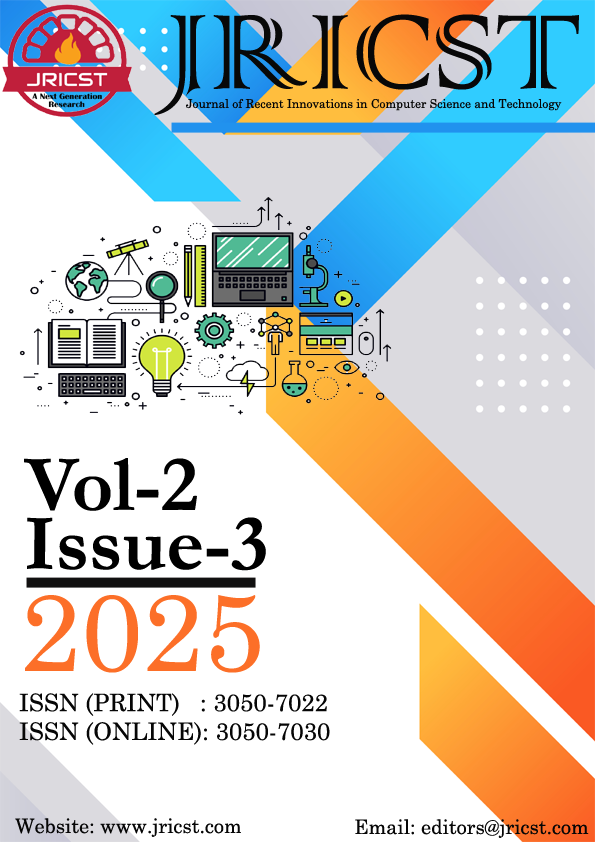Enhancing AI Decision-Making: Sensitivity Analysis, Hyperparameter Optimization, Multi-Agent Collaboration, and AI-Human Comparisons
DOI:
https://doi.org/10.70454/JRICST.2025.20302Keywords:
Decision-Making, Sensitivity Analysis, Hyper parameter Optimization, Multi-Agent Systems, AI vs. Human Reasoning, Ethical AIAbstract
Artificial intelligence (AI) has significantly influ
enced decision-making processes across various domains, in
cluding law, healthcare, and autonomous systems. Despite its
advancements, AI models face several critical challenges, in
cluding sensitivity to input variations, hyperparameter tuning
complexities, coordination issues in multi-agent environments,
and fundamental differences in decision-making compared to
human cognition. This study investigates four key dimensions
of AI decision-making: (1) the impact of input perturbations on
AI-generated responses, (2) the role of hyperparameter tuning
in optimizing AI performance, (3) the effectiveness of multi
agent AI collaboration in ethical and strategic dilemmas, and
(4) a comparative analysis of AI and human reasoning in real
world scenarios. The findings indicate that AI models exhibit
response inconsistencies with minor input rewording, hyperpa
rameter tuning significantly alters model accuracy and coherence,
multi-agent AI systems struggle with consensus-building, and AI
decision-making lacks ethical and emotional depth compared to
human reasoning. This study highlights the need for robust AI
training methodologies, structured decision-making protocols in
multi-agent AI systems, and enhanced explainability frameworks
to improve AI’s effectiveness and reliability in real-world appli
cations.
Downloads
References
[1] S. K. Pattanayak, M. Bhoyar, and T. Adimulam, “Deep reinforcement learning for complex decision-making tasks,” Int. J. Innov. Res. Sci. Eng. Technol., vol. 13, no. 11, pp. 18205–18220, 2024. doi: 10.15680/IJIRSET.2024.1311017.
[2] C. J. X. Cruz, “Transforming competition into collaboration: The revolutionary role of multi-agent systems and language models in modern organizations,” arXiv preprint arXiv:2403.07769, 2024. [Online]. Available: https://doi.org/10.48550/arXiv.2403.07769
[3] N. Bakas, S. Lavdas, K. Vavousis, C. Christodoulou, and A. Langousis, “Automated machine learning in a multi-agent environment,” in Proc. Eur. Mediterr. Middle East Conf. Inf. Syst., Cham, Switzerland: Springer Nature, 2024, pp. 47–57. doi: 10.1007/978-3-031-81322-1_4.
[4] I. H. Ahmed et al., “Deep reinforcement learning for multi-agent interaction,” AI Commun., vol. 35, no. 4, pp. 357–368, 2022. doi: 10.3233/AIC-220116.
[5] M. S. Islam et al., “Human-AI collaboration in real-world complex environment with reinforcement learning,” Neural Comput. Appl., pp. 1–31, 2025. doi: 10.1007/s00521-025-11288-1.
[6] A. K. Kalusivalingam, A. Sharma, N. Patel, and V. Singh, “Optimizing decision-making with AI-enhanced support systems: Leveraging reinforcement learning and Bayesian networks,” Int. J. AI ML, vol. 1, no. 2, 2020. [Online]. Available: https://www.cognitivecomputingjournal.com/index.php/IJAIML-V1/article/view/59
[7] K. Hu et al., “A review of research on reinforcement learning algorithms for multi-agents,” Neurocomputing, Art. no. 128068, 2024. doi: 10.1016/j.neucom.2024.128068.
[8] S. Triantafyllou, A. Sukovic, Y. Zolfimoselo, and G. Radanovic, “Counterfactual effect decomposition in multi-agent sequential decision making,” arXiv preprint arXiv:2410.12539, 2024. [Online]. Available: https://doi.org/10.48550/arXiv.2410.12539
[9] G. Yu, “Designing behavior-aware AI systems to influence human decision-making,” Ph.D. dissertation, Washington Univ. in St. Louis, St. Louis, MO, USA, 2024. [Online]. Available: https://www.proquest.com/openview/bfc10ca5b710a177f3302bd9a4230c43/1?pq-origsite=gscholar&cbl=18750&diss=y
[10] A. N. Abbas et al., “Analyzing operator states and the impact of AI-enhanced decision support in control rooms: A human-in-the-loop specialized reinforcement learning framework for intervention strategies,” Int. J. Human-Comput. Interact., pp. 1–35, 2024. doi: 10.1080/10447318.2024.2391605.
[11] A. Esmaeili, “Multi-agent-based collaborative machine learning in distributed resource environments,” Ph.D. dissertation, Purdue Univ. Graduate School, West Lafayette, IN, USA, 2024. [Online]. Available: https://hammer.purdue.edu/articles/thesis/Multi-Agent-Based_Collaborative_Machine_Learning_in_Distributed_Resource_Environments/26314504?file=47778727
[12] I. De Zarzà, J. De Curtò, G. Roig, P. Manzoni, and C. T. Calafate, “Emergent cooperation and strategy adaptation in multi-agent systems: An extended coevolutionary theory with LLMs,” Electronics, vol. 12, no. 12, Art. no. 2722, 2023. doi: 10.3390/electronics12122722.
[13] Z. Aref, S. Wei, and N. B. Mandayam, “Human-AI collaboration in cloud security: Cognitive hierarchy-driven deep reinforcement learning,” arXiv preprint arXiv:2502.16054, 2025. [Online]. Available: https://doi.org/10.48550/arXiv.2502.16054
[14] L. Hammond et al., “Multi-agent risks from advanced AI,” arXiv preprint arXiv:2502.14143, 2025. [Online]. Available: https://doi.org/10.48550/arXiv.2502.14143
Downloads
Published
Issue
Section
License
Copyright (c) 2025 Manish Kumar, Dr Jugnesh Kumar (Author)

This work is licensed under a Creative Commons Attribution 4.0 International License.
This is an Open Access article distributed under the term's of the Creative Common Attribution 4.0 International License permitting all use, distribution, and reproduction in any medium, provided the work is properly cited.






